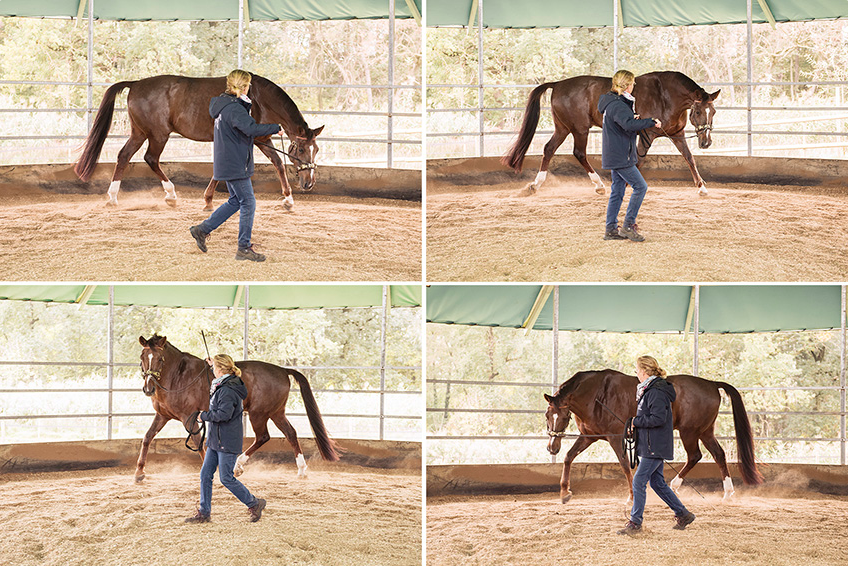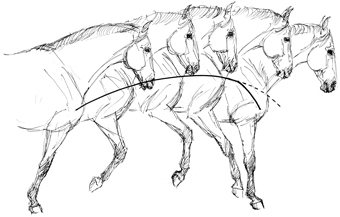Gymnastize the equine athlete? Yes please!

Whether amateur or elite athlete: stretching exercises are part of the standard repertoire for every sports enthusiast. In horse training, however, every formal deviation from the textbook lesson has a dubious reputation – quite unjustifiably, if you know the sport physiological background.
Basically, training theory distinguishes between dynamic and static stretching. While dynamic stretching involves holding the stretched position in a springy manner for a short time and then immediately leaving it again, and this in several repetitions, static stretching involves holding the stretching position for longer. Dynamic stretching prepares the body, muscles and fascia for a specific sporting activity and loosens up the structures. With static stretching, you go deeper into the structures, which is why the muscles are less efficient afterwards and such exercises should not be practised before a sporting activity. Whether dynamic or static, stretching postures should always be pain-free!
We know from the human field that mobility and stability must go hand in hand in order to keep the risk of injury as low as possible. Therefore, an appropriate stretching programme is part of any sensible muscle-building training.
So why is dynamic stretching of the horse in training so vehemently rejected? In the end, is it perhaps a linguistic misunderstanding? In equitation, the term "stretching" is almost unknown. For example, a deviation of the neck from the longitudinal axis is called "bending". If the bend in a horse is increased beyond the measure of the curved line (circle, volte, etc.), it is even called "overbending" – usually in a reprehensible tone of voice, as if cruelty to animals were not far away.
Let's once again build a bridge to training theory in humans: Would you call the forward fold, the lunge or the cat pose an everyday posture or a working posture? Hardly! Nevertheless, these stretching exercises are indisputably invaluable for releasing tension, stimulating blood circulation and optimising the performance of fasciae and muscles. The same applies to the horse: overbending must never be a permanent posture and certainly not a posture held by humans with force! Rather, the four-legged athlete should be invited with subtle, repetitive stimuli to temporarily adopt this stretching posture – always springy and pain-free.
Stretching or "gymnastics", as it is also called in horse training, is a basic requirement for every two-legged and four-legged athlete to be able to do sport in a health-conscious way. Through the calm and releasing exercises, the body experiences a certain relaxation, the metabolism is stimulated and the blood circulation of the muscles is optimised. As the saying goes, "In a healthy body there is a healthy mind." This actually means: If the body is functioning well, the mental area is also doing fine!
In our Straightness Training and our Anatomically Correct Horsemenship training, we attach great importance to the targeted gymnastics or stretching of the neck. The sensitive and gradual overbending of the immensely strong neck muscles promotes throughness and clears the way to the shoulder and then through the body diagonal to the hindquarters. You could almost say that we mobilise the horses from front to back in order to finally stabilise them from back to front. This training, however, must be done without aids such as a side-rein or a supporting stick in order to be functional and have a lasting effect – both on the lunge line and under the rider.
However, our stretching work with the neck overbending to one side is by no means a permanent condition or eternal work! This intensive stretching phase stands at the very beginning of our training programme, which aims to guide the horse into horizontal and vertical balance, because horses are naturally front-heavy and hollow on one side of the body and stiff on the other (right-handed or left-handed). In order to keep our horses healthy and powerful in the long term, we have to give them the opportunity to use their strength through targeted functional training in such a way that joints, muscles, ligaments and tendons are protected – no matter in which discipline and performance class we are riding our four-legged friends.
But how do we achieve the correction of this handedness and front heaviness? If we imagine the crooked horse in a simplified way, it always puts more weight on its dominant (handed) front leg, as if it were "a bit shorter" than the other three legs. The structures on the opposite side of the body are correspondingly shortened and little stretched: To compensate for this imbalance, it uses its neck as a balancing rod. In this way, it turns head and neck outwards in the circle if it is not prevented from doing so with rein pressure or restricting lunging equipment. In this crooked posture there is always tension in the whole horse, which can end up in compensatory muscles, pain and injuries. So how can we get the metaphorically speaking "shorter leg" to grow to the length of the other three legs, i.e. to extend its range of movement? By teaching the horse to stop using the neck as a balancing rod and steering element and instead balance its body on the hindquarters. This is what we do with Straightness Training.
In this functional lunging training, the neck is gradually made more flexible on both sides by means of springy, dynamic stretching. The training is done exclusively at the trot, as the diagonal step sequence of this gait makes it easier for the horse to shift diagonally from the inner front leg to the outer hind leg. The stretching training starts with the eye muscles via the gaze steering and finally ends on the diagonal outer hind leg. The load is thus gradually shifted from the inner front leg to the outer hind leg. Now the inner front leg becomes free and can "grow". Many short training sessions are necessary for successful gymnastics. The first sessions last about 10 minutes, during which the hand is changed regularly and the horse is given short breaks to think. As we work on the primal instinct of flight as well as the deep postural muscles and fascia tissue with this functional training, the lunging work is mentally and physically extremely tiring for the horse at the beginning. It takes a lot of experience and sensitivity not to put the horse under unnecessary strain.
If the complete and bilateral neck throughness is achieved after three to four weeks, the diagonal shift to the outer hind leg will work: Now the horse no longer needs the overbending, but can be lunged and ridden in flexion and bend. Only now and then should the horse be invited to overbend dynamically by means of impulses in order to check the thoroughness in the neck and to consolidate the diagonal shift in the horse in the long term. With this training, the natural movement pattern of the flight animal is permanently changed. In order to internalise this, the horse's body needs a certain amount of time and several repetitions to profoundly establish this new and comfortable state of balance: dynamic stretching of the neck – diagonal shifting of the load! You can imagine this like cycling in humans: If you pedal again and again as a child in play, you will have no trouble with the balance state on two wheels which is completely unnatural for humans, even when you sit again on a bicycle as an adult after 30 years without cycling.
The ultimate goal of this well-dosed yet intense stretching is to transform the biomechanics of the flight animal into the biomechanics of the athlete, just as nature dictates: Our role model must be the movement pattern of the stallion or the lead mare, who protectively circle their herd or foal in an arched up posture – a movement pattern in which they are optimally agile, responsive and strong. So-called "breeding progress" has not changed this fundamental fact. On the contrary: modern horses – and this does not only apply to warmbloods, but just as much to Icelandic horses, Haflingers or Quarterhorses – are nowadays equipped with an enormous action of the hindquarters, and only the early and sustainable transformation of this thrust into load-bearing capacity can guarantee a long-term, injury-free use of these horses. Our many years of experience have shown that it is precisely this lack of conversion from thrust to load-bearing capacity that is the cause of many medical problems that confront vets, therapists and trainers with seemingly unsolvable puzzles. It is one of the reasons why far too many highly talented horses disappear from the sporting scene at a young age. The still widespread misconception that horses should not be put on the hindquarters too early is the undoing of these wonderful creatures.
The overbending, and thus the transformation of thrust into load-bearing capacity, is therefore anything but a harmful forced posture. With the necessary sensitivity, dynamic stretching is rather perceived by the horse as releasing and activating. Body and mind find harmony and joy in working together with the human being, to whom it gladly makes its strength and willingness to perform available. And you, have you already stretched today?
